Water is the lifeblood of any successful wildlife garden, and in Florida’s warm climate, providing reliable water sources becomes even more critical for supporting local fauna. Thankfully, offering water for wildlife in your garden is an easy way to increase the diversity of living creatures in your landscape.
From tiny hummingbirds to visiting deer, every creature needs access to clean, fresh water for drinking, bathing, and cooling. Creating diverse water features in your Florida garden not only attracts a wider variety of wildlife but also helps sustain them through the state’s intense summer heat and occasional drought periods.
Bird Baths: The Foundation of Adding Water for Wildlife
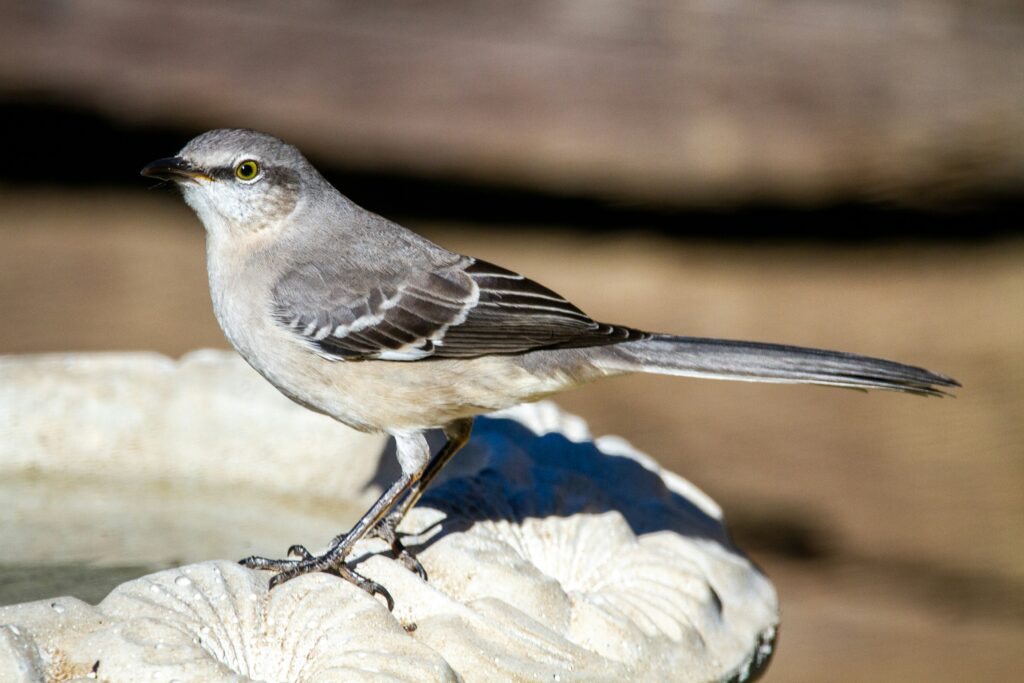
Bird baths serve as the cornerstone of wildlife water provision, offering an accessible and manageable starting point for any Florida gardener. The key to successful bird bath placement lies in understanding the varied needs of Florida’s diverse bird population, from the smallest wrens to larger species like mockingbirds and blue jays.
Design Considerations for Florida Bird Baths
Shallow areas are absolutely essential in bird bath design, but the specific requirements vary dramatically based on the diverse bird species that call Florida home. Understanding these varied needs allows you to create water features that serve your local avian community effectively.
Accommodating Small Songbirds
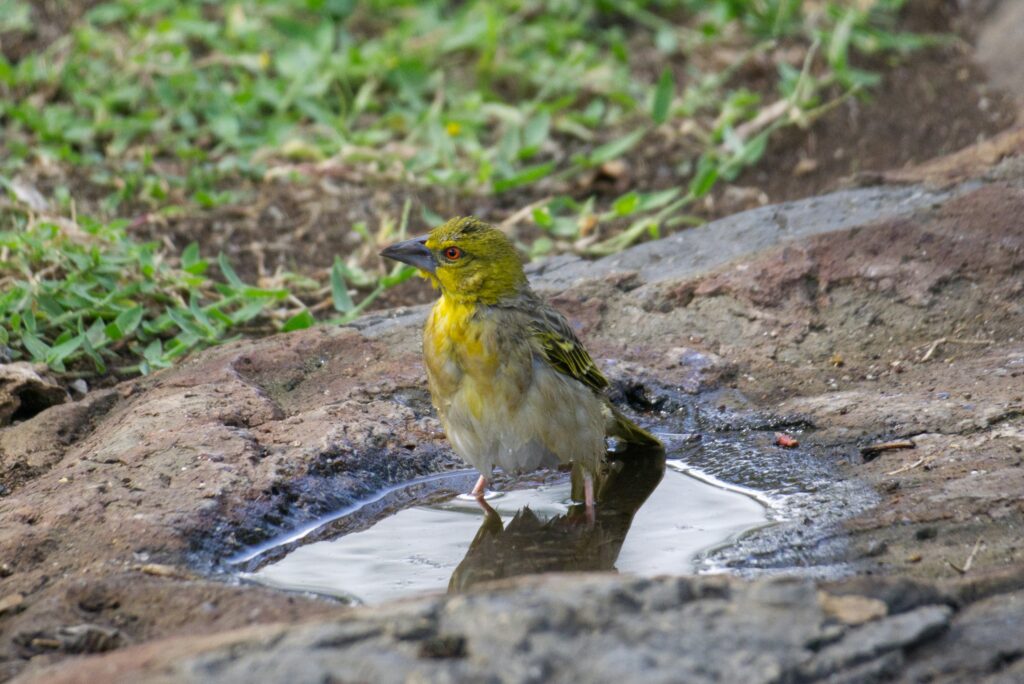
Florida’s abundant small songbirds, including Carolina wrens, house wrens, and various warbler species, require extremely shallow water depths of just half an inch to one inch. These tiny birds, weighing less than an ounce, can easily drown in deeper water and prefer basins with gentle, gradual slopes.
Carolina chickadees and tufted titmice follow similar preferences, often approaching water features in small flocks and appreciating multiple shallow access points around the basin’s perimeter.
For these species, choose bird baths with textured bottoms or add a layer of clean pea gravel to provide secure footing. Position these baths 3-4 feet high on pedestals near shrubs or small trees where these birds typically forage, allowing them quick escape routes to familiar territory.
Serving Medium-Sized Residents
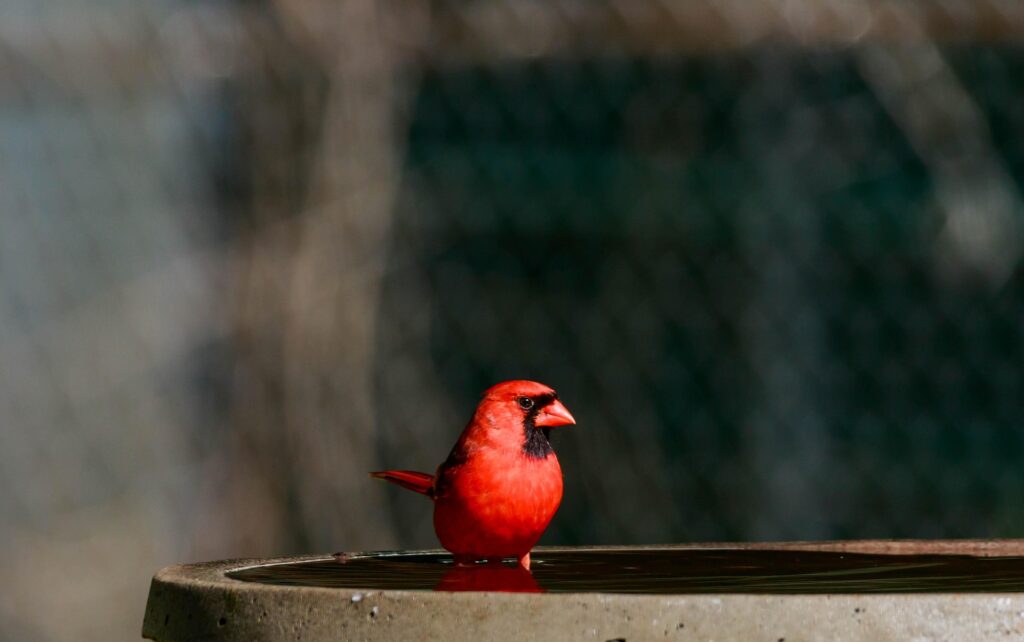
Florida’s medium-sized birds, including northern cardinals, blue jays, and northern mockingbirds, prefer water depths of 1-2 inches with basin diameters of at least 18-20 inches to accommodate their larger wingspans during bathing.
Cardinals, being somewhat secretive birds, appreciate bird baths placed near dense shrubs or understory plantings where they can observe the area before approaching.
Blue jays, being highly social and sometimes aggressive at water sources, benefit from larger basins that can accommodate multiple birds or from having several water sources spread throughout the garden to reduce competition. Their intelligence means they quickly learn the locations of reliable water sources and will often cache food nearby.
Northern mockingbirds, known for their territorial behavior, may dominate a single water source. Providing multiple bird baths 30-50 feet apart helps ensure smaller species can access water even when mockingbirds are present.
Accommodating Florida’s Larger Birds
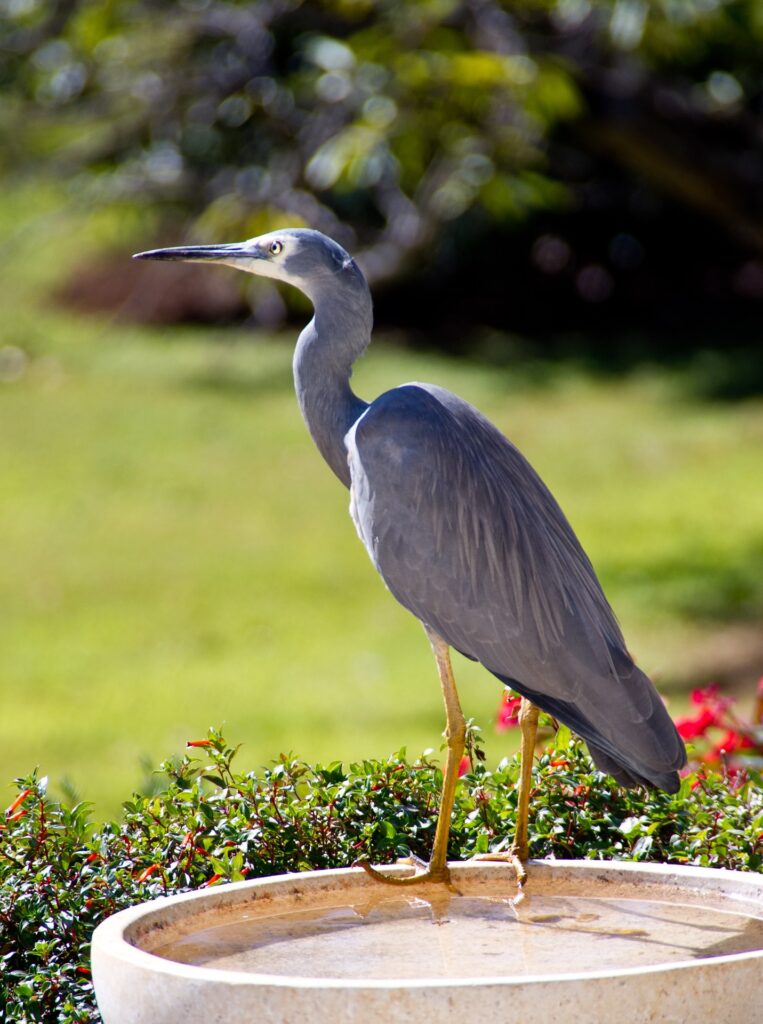
Larger species like pileated woodpeckers, red-shouldered hawks, and various heron species require different considerations entirely. While these birds may occasionally use traditional bird baths, they’re more likely to appreciate ground-level water sources or very large, sturdy basins positioned 1-2 feet high.
Pileated woodpeckers, Florida’s largest woodpecker species, need robust basins that won’t tip under their substantial weight. These impressive birds prefer water sources near mature trees and appreciate deeper areas (2-3 inches) where they can fully immerse their distinctive red crests.
Ground-Level Visitors
Many Florida species prefer or require ground-level water access. Northern bobwhites, mourning doves, and various thrush species naturally seek water at ground level, reflecting their typical foraging and living patterns.
Create shallow ground-level basins or depressions lined with stones, positioned in areas with good visibility to allow these birds to watch for predators while drinking.
Ground doves, common in Florida’s residential areas, are particularly fond of very shallow water sources placed in sandy or bare soil areas that mimic their natural habitat preferences.
Hummingbird Specifications
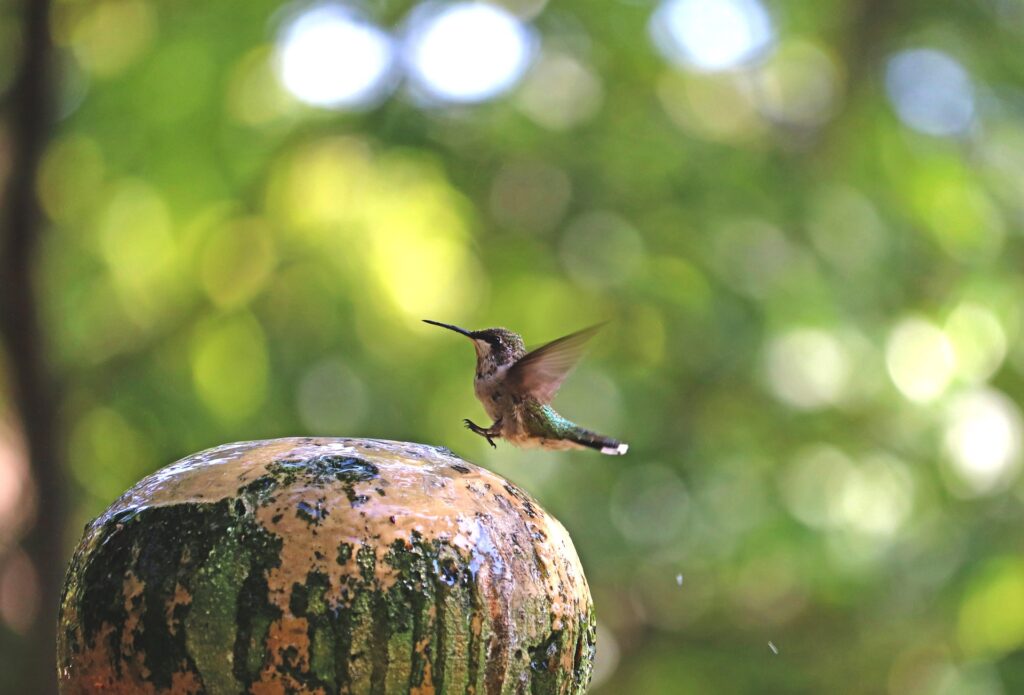
Ruby-throated hummingbirds and the occasional vagrant hummingbird species visiting Florida have unique requirements that standard bird baths rarely meet. These tiny birds prefer moving water and extremely shallow depths of just 1/4 inch or less. They often prefer to fly through mist or light spray rather than landing to drink.
Consider adding a small dripper, mister, or fountain feature specifically for hummingbirds. Position these near flowering plants that attract hummingbirds, such as native firebush, coral honeysuckle, or cardinal flower.
The sound and movement of dripping or misting water serves as an audible attractant for these high-energy birds.
Seasonal Visitor Accommodations
Florida’s winter visitors, including various warbler species, white-throated sparrows, and painted buntings, arrive with different preferences shaped by their breeding habitats further north. Many of these species appreciate slightly deeper water (1-2 inches) and larger basins than year-round Florida residents.
Painted buntings, among Florida’s most spectacular winter visitors, tend to be secretive and prefer water sources with dense cover nearby. Position basins for these species near native shrubs like beautyberry or firebush, which also provide food sources that these birds prefer.
The basin should have a rough texture or include strategically placed stones to provide secure footing, preventing birds from slipping on smooth surfaces. Different textures appeal to different species – smooth river rocks work well for larger birds, while rough surfaces or fine gravel better serve smaller species with delicate feet.
Placement and Maintenance for Different Species
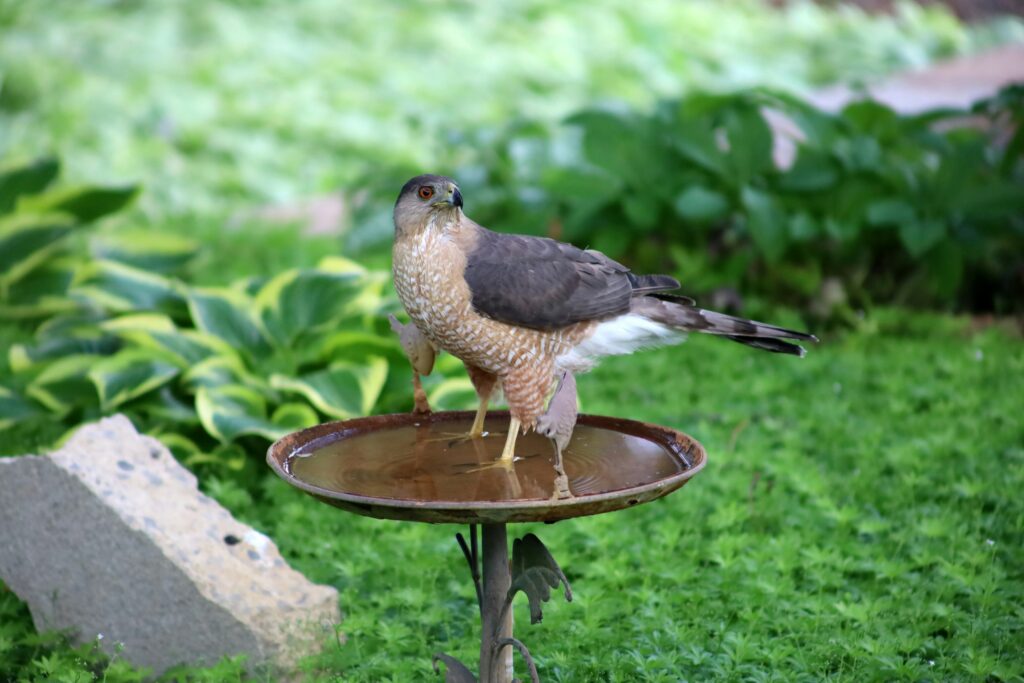
Strategic placement becomes crucial when serving Florida’s diverse bird communities, as different species have vastly different comfort levels and behavioral patterns around water sources.
Height Preferences by Species
Ground-feeding species like towhees, thrashers, and various sparrow species prefer water sources positioned 1-2 feet high or at ground level, matching their natural foraging patterns. These birds feel most secure when water sources align with their typical activity zones.
Mid-level foragers, including cardinals, mockingbirds, and blue jays, prefer bird baths positioned 3-4 feet high, allowing them to maintain their preferred perching and observation heights while accessing water.
Canopy species, such as various warbler species and vireos, often prefer elevated water sources 4-6 feet high, positioned near or within the tree canopy where they spend most of their time foraging.
Proximity to Cover and Escape Routes
Different bird species require varying distances from protective cover. Nervous species like Carolina wrens and various warbler species need water sources within 3-6 feet of dense shrubs or brush piles for quick escape routes. These species rarely venture into completely open areas for water.
More confident species like blue jays and mockingbirds can handle water sources 10-15 feet from cover, though they still appreciate nearby perching spots for surveillance before approaching.
Territorial species benefit from water sources positioned near the edges of their territory boundaries, allowing them to drink while maintaining visual contact with their defended areas.
- NO DIG NATURE POOL – Easy to build, parts click and fit together easily to set up in under an hour!
- INCLUDES FOUNTAIN PUMP – The kit includes our Pond Fountain Pump (pumps 184 gallons per hour) to help create a stunning water feature.
- COMPLETE WATER FEATURE KIT – Includes wood effect resin panels, fibre reinforced underlay, bird landing beach with planting pocket and wildlife ladder
- ATTRACT NATURE TO YOUR YARD – With this beautiful water feature you will attract birds and wildlife to your yard, the wildlife ladder is perfect and safe for frogs, toads and other water loving creatures
- PERFECT FOR YARDS, PATIOS & BALCONIES – Pool volume 42 gallons (190 litres), Pool dimensions 37.4” wide x 37.4” long x 14” high
Multiple Bath Strategy for Species Diversity
To truly serve Florida’s bird diversity, consider implementing a multiple bath strategy with different specifications:
- A shallow ground-level basin (1/2 inch deep) near dense native shrubs for secretive species
- A mid-height pedestal bath (3 feet high, 1-2 inches deep) in a partially open area for confident species
- An elevated basin (5-6 feet high) attached to or near trees for canopy-dwelling species
- A dripper or mister system near flowering plants specifically for hummingbirds
Position these various water sources 20-30 feet apart to reduce competition and allow multiple species to use water simultaneously without conflict.
Daily maintenance becomes crucial in Florida’s climate, with specific attention to the needs of regular visitors. Change the water every day or two to prevent mosquito breeding and bacterial and algal growth. During summer months, you may need to refill baths multiple times due to rapid evaporation.
Monitor which species use which water sources to fine-tune placement and maintenance schedules. Some species, like blue jays, create more mess and may require more frequent cleaning, while others, like small warblers, have minimal impact on water cleanliness.
Adding a dripper or small fountain not only creates movement that attracts birds but also helps prevent stagnation. The sound of moving water can attract species from surprising distances, with some birds responding to the audio cue from over 100 feet away.
Small Ponds: Creating Aquatic Ecosystems
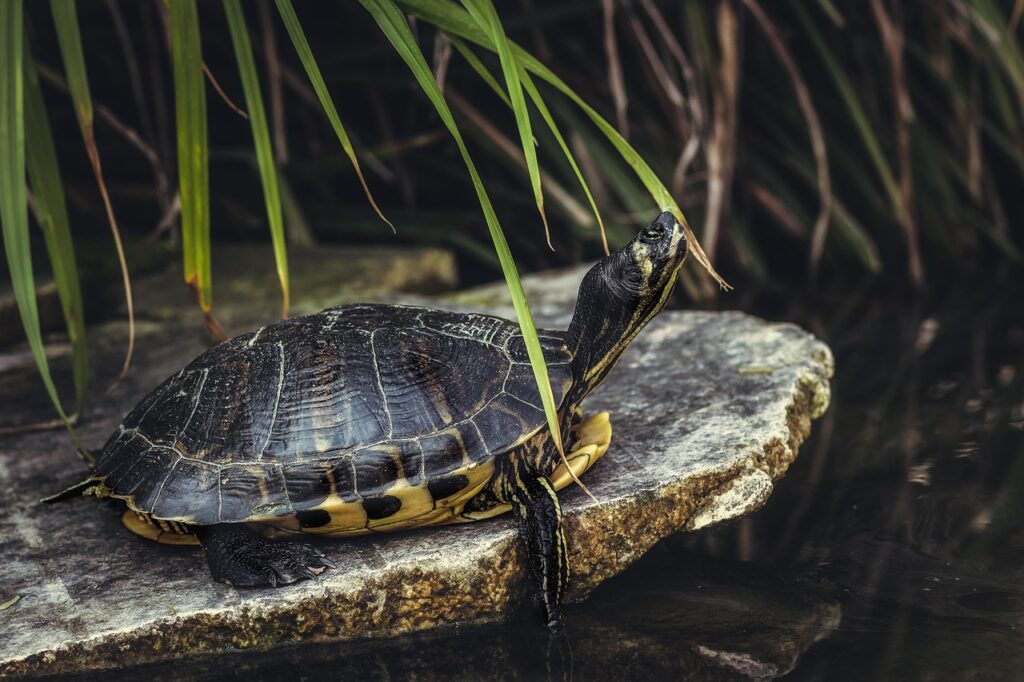
Small ponds represent a significant step up in wildlife habitat creation, supporting not just birds but also frogs, turtles, dragonflies, and other aquatic creatures native to Florida. A well-designed pond becomes a miniature ecosystem that can dramatically increase the biodiversity of your garden.
Size and Depth Requirements
Even a small pond measuring 4 to 6 feet across can make a substantial impact on wildlife attraction. The ideal design incorporates multiple depth zones: shallow edges of 2 to 4 inches for drinking and bathing, intermediate depths of 6 to 12 inches for amphibians, and a deeper center section of 18 to 24 inches to provide cooler water during hot weather and prevent complete freezing during rare cold snaps.
- [Compact & Aesthetic Mini Garden Pond] Bring the sights and sounds of flowing water to your home, patio, balcony, office, or garden. This compact mini garden pond, crafted from premium materials with an all-in-one design, creates a serene and relaxing atmosphere, perfect for enhancing both indoor and outdoor spaces.
- [Ultra-Quiet and Long-Lasting Water Pump]The included fish pond water pump features a brushless motor, ensuring long-lasting, silent operation. This low-noise water fountain pump creates a peaceful environment The gentle sound of flowing water creates a relaxing atmosphere, perfect for unwinding or enhancing your outdoor or indoor space.
- [Built-In Waterfall with LED Lighting]Designed with an integrated waterfall, this mini patio pond includes a warm yellow LED light strip, adding a captivating glow to your garden or indoor pond. The cascading water enhances relaxation while creating an eye-catching centerpiece, whether used as a water fountain for fish ponds or a decorative indoor water feature.
- [Unique Design for Freely DIY]With its upper shelf and versatile design, you can personalize your small fish pond by adding aquatic plants, pebbles, decorative stones, or even small fish and turtles. This mini pond for patio and balcony allows endless creative possibilities, making it a stylish addition to outdoor ponds, fish tanks, or indoor garden decor.
- [Easy Assembly – Instant Enjoyment]Setting up your indoor garden pond is quick and effortless. With clear instructions and all necessary accessories included, you can have your mini fish pond ready in minutes. Perfect for beginners and pond enthusiasts alike, this fish pond kit makes it easy to create a serene water fountain feature anywhere.
Natural Filtration and Plant Integration for Specific Wildlife
Florida’s abundant sunshine can quickly turn a small pond into a green, algae-filled mess without proper planning, but strategic plant selection serves dual purposes: maintaining water quality while attracting specific bird species and beneficial insects that enhance your garden’s ecosystem.
Aquatic Plants for Water Clarity and Bird Attraction
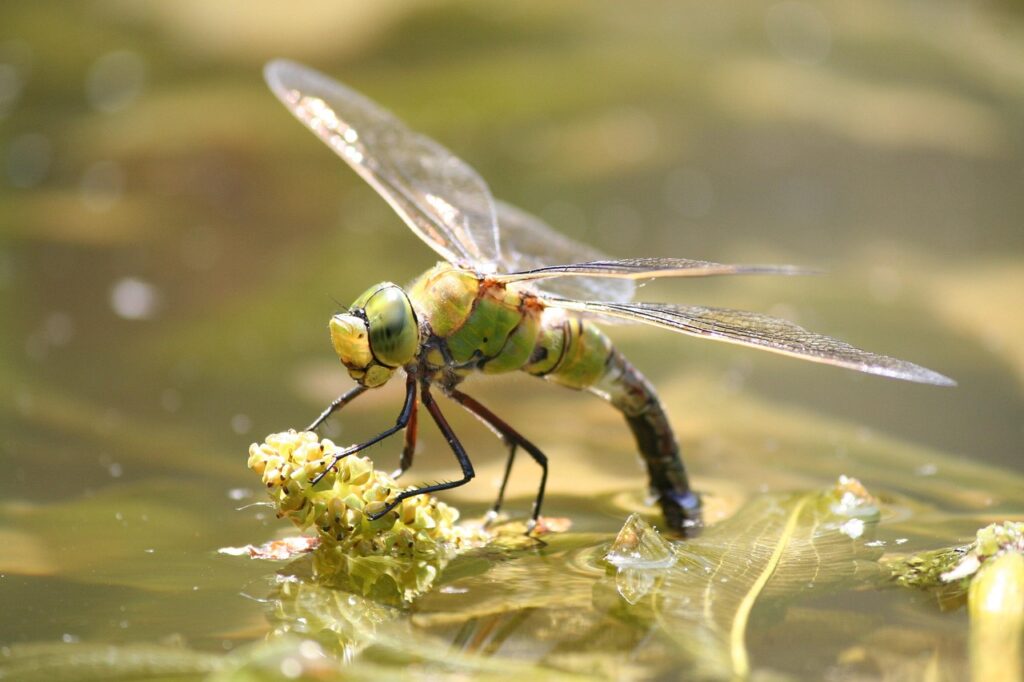
Submerged oxygenating plants form the foundation of natural pond filtration while creating habitat for insects that many Florida birds depend upon.
Vallisneria (wild celery) produces long, ribbon-like leaves that sway gracefully underwater while hosting midge larvae, small crustaceans, and other aquatic invertebrates that attract diving ducks during winter migration periods.
Cabomba (fanwort) creates dense underwater forests that serve as nurseries for dragonfly and damselfly nymphs. Adult dragonflies emerging from ponds with established cabomba populations provide excellent mosquito control throughout your garden while attracting flycatcher species like eastern phoebes and great crested flycatchers that specialize in catching these aerial insects.
Hornwort, a rootless floating plant, excels at nutrient uptake while providing spawning habitat for beneficial insects. The dense growth creates perfect hunting grounds for small fish that control mosquito larvae, while the plant’s feathery texture attracts egg-laying sites for beneficial midges that feed many songbird species.
Floating Plants for Surface Coverage and Songbird Habitat
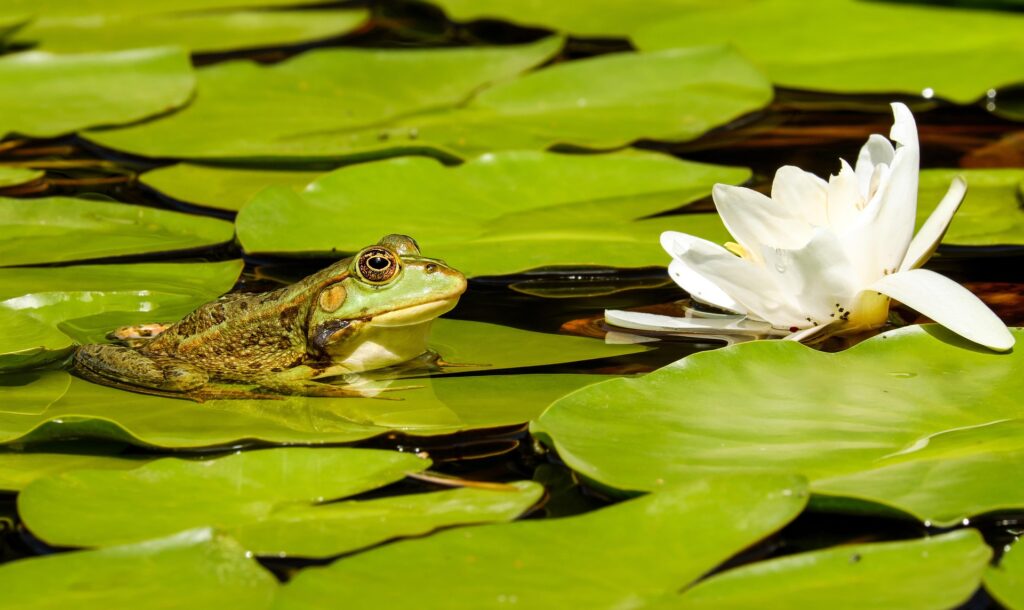
Water lilies serve multiple wildlife functions beyond their obvious beauty. Native fragrant water lilies (Nymphaea odorata) provide landing platforms for red-winged blackbirds and common grackles, which often forage for insects among the lily pads. The flowers attract native bees and butterflies, while the large leaves create shade that keeps water temperatures comfortable for amphibians.
American lotus (Nelumbo lutea), where space permits, creates dramatic vertical elements that attract different bird species. The large seed pods provide food for waterfowl, while the broad leaves serve as hunting perches for green herons and night-herons seeking fish and frogs in the water below.
Marginal Plants for Transition Zones and Nesting Habitat
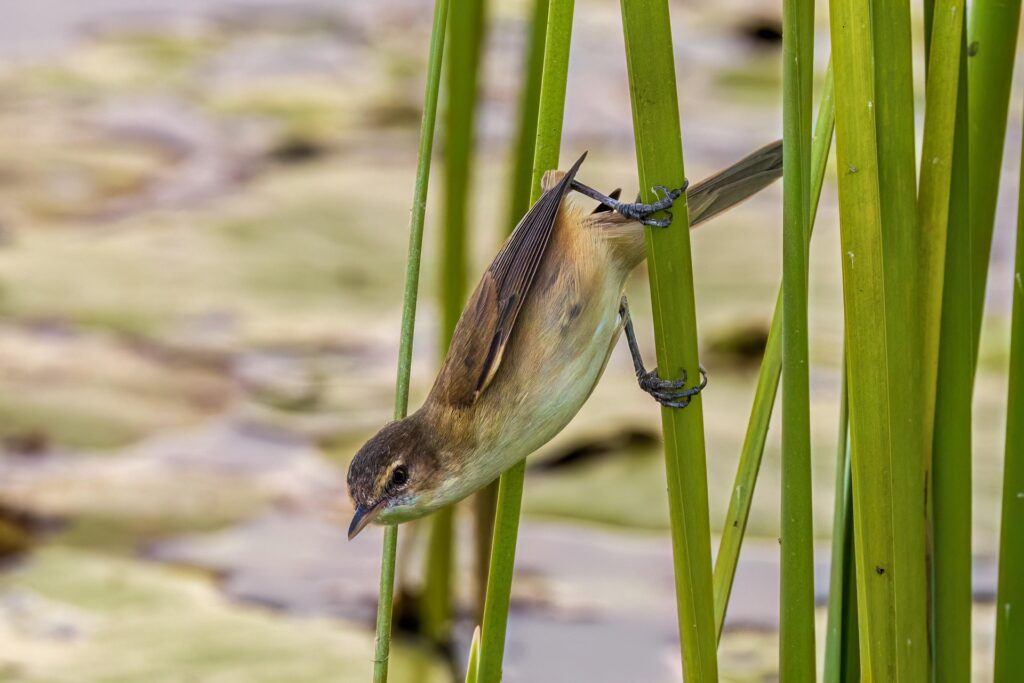
Blue flag iris (Iris virginica) creates a vertical structure along pond edges that many bird species utilize for different purposes. Red-winged blackbirds often weave their nests among iris leaves, while the flowers attract native bees that eastern bluebirds and other insectivorous birds hunt. The seed heads provide late-season food for finches and sparrows.
Pickerelweed (Pontederia cordata) produces spikes of blue flowers that attract native bees, butterflies, and beneficial wasps. The seeds feed various waterfowl species, while the broad leaves provide cover for frogs and small fish. Great blue herons often hunt from positions near pickerelweed stands, using the plants as visual barriers.
Duck potato (Sagittaria latifolia) earned its name from waterfowl’s preference for its nutritious tubers, but the plant serves resident birds year-round. The white flowers attract small native bees that provide protein for wrens and chickadees feeding nestlings, while the distinctive arrow-shaped leaves create hunting perches for kingfishers and flycatchers.
Soft rush (Juncus effusus) provides dense, grass-like growth that many small birds use for nesting material. Red-winged blackbirds, marsh wrens, and various sparrow species appreciate the cover soft rush provides, while the inconspicuous flowers host tiny beneficial insects that support insectivorous songbirds.
Specialized Plants for Beneficial Insect Production
Wild rice (Zizania aquatica), where water depth and space allow, creates tall grassland-like habitat that attracts seed-eating birds like bobolinks during migration while hosting numerous beneficial insects in its stems and seed heads. The plant requires deeper water (12-18 inches) but produces exceptional wildlife value.
Arrowhead species (Sagittaria spp.) create a varied habitat structure that supports different insect communities at different heights. The submerged portions host aquatic insects, the floating leaves provide egg-laying sites for beneficial insects, and the emergent flower spikes attract pollinators that feed aerial insectivores.
Container Pond Solutions for Limited Space Gardens
- Transform Any Space with a Beautiful Waterfall Feature – Bring the sights and sounds of flowing water to indoor and outdoor areas, including homes, patios, balconies, offices, and gardens, creating a serene and relaxing atmosphere.
- Complete Kit with LED Lighting & Pump – Includes a built-in LED waterfall light, energy-efficient water pump, low-suction attachment, and two types of decorative gravel for a beautiful display day or night.
- Customizable & Versatile Design – Personalize with aquatic plants, stones, driftwood, or fish to craft a unique, self-contained water feature that enhances any home or outdoor décor.
- Durable & Stylish Construction – Designed with a sleek, contemporary look in Steel Gray or Rustic Brown, this compact 23.5-inch wide container holds 5-7 gallons of water and integrates seamlessly into modern and natural spaces.
- Quick & Simple Setup – Enjoy a low-maintenance water feature in minutes—just fill with water, plug it in, and relax as the gentle waterfall sound creates a calming ambiance for any environment.
Container ponds offer an excellent alternative for renters, apartment dwellers, or gardeners with challenging soil conditions, providing many of the same wildlife benefits as in-ground ponds while offering flexibility and easier maintenance.
Selecting Appropriate Container Types and Sizes
- Made of durable and thick polypropylene material with marble texture that is crack, chip and fade resistant for indoor and outdoor use
- Unique round shaped design that is lighter than ceramic pots and easy to move for decorating tabletops, home, office, patio, garden or desk
- Suitable as a water planter for hydroponics plants without drainage hole at the bottom and can also be used as a base for tabletop fountain
- Versatile 15.6 inch diameter by 7.8 inch height size works great as a large planter pot or bird bath and holds enough water for birds to bathe in
- Comes in stylish colors like Earth Yellow, Blue Black and Ash Black that make beautiful displays for gardens, kitchens and more
Large ceramic or resin planters, ranging from 15-25 gallons, provide sufficient water volume for small ecosystems while remaining manageable for maintenance. Whiskey barrels lined with pond liner create rustic, natural-looking water features that blend seamlessly with Florida’s landscape aesthetic.
For maximum wildlife impact, choose containers at least 18 inches deep and 24 inches across to provide adequate space for both plants and visiting wildlife.
Half-barrel containers work exceptionally well for single-species plant displays that attract specific wildlife. A half-barrel planted exclusively with pickerelweed creates a specialized habitat for native bees and butterflies while providing drinking water for birds.
Large, wide ceramic bowls (12-15 inches deep, 30+ inches across) create excellent shallow-water habitats perfect for amphibians and ground-feeding birds. These low-profile containers work especially well on patios or decks where deeper containers might obstruct views or create safety concerns.
Multi-Container Systems for Maximum Diversity
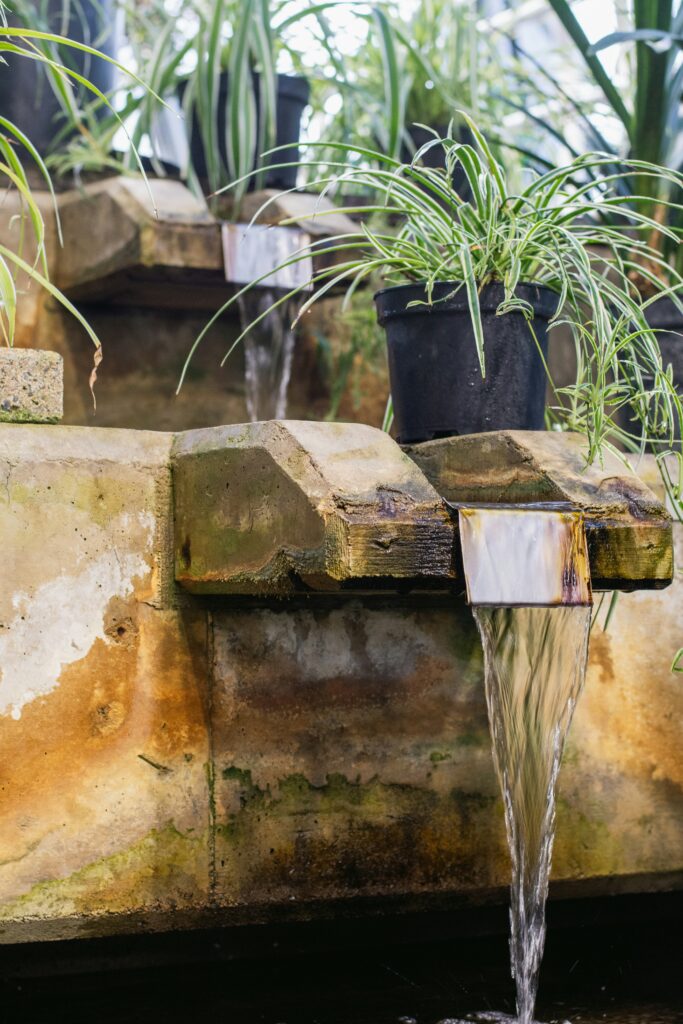
Creating clusters of different-sized containers allows you to replicate the varied habitat zones found in natural ponds. Position a deep container (20+ inches) planted with water lilies adjacent to a shallow container (6-8 inches deep) planted with marginal species like arrowhead or duck potato.
Connect multiple containers with small pumps or gravity-fed systems to create water movement between different habitat zones. A tall, narrow container planted with soft rush can overflow into a wider, shallower container planted with pickerelweed, creating the sound and movement that attracts birds while providing varied plant communities.
Stagger container heights using plant stands, blocks, or built-in deck features to create a waterfall effect that increases oxygen levels and provides the sound of moving water that many bird species find irresistible.
Depth Zones Within Single Containers
Even single containers can provide varied habitat by creating different depth zones using techniques borrowed from traditional pond construction. Place inverted plastic pots or specially designed plant stands within larger containers to create shallow areas for marginal plants while maintaining deeper zones for submerged vegetation.
Use stacks of smooth stones or purpose-built plant ledges to create stepped environments within deep containers. Position pickerelweed and arrowhead on the highest ledges (4-6 inches below the water surface), blue flag iris on middle ledges (8-10 inches deep), and water lilies in the deepest areas (12-15 inches deep).
Plant Selection for Container Pond Systems
Container ponds require careful plant selection due to limited space and root restrictions, but proper choices can create surprisingly diverse wildlife habitats in compact spaces.
Dwarf and Compact Varieties for Small Spaces

Dwarf water lilies like ‘Helvola’ or ‘Pygmaea Alba’ provide classic water lily benefits in containers as small as 15 gallons. These compact varieties still attract the same beneficial insects and provide bird perching opportunities as their larger cousins while fitting comfortably in limited space.
Dwarf cattails (Typha minima) offer the classic cattail silhouette and wildlife benefits without the aggressive spreading habits of full-sized species. These compact plants provide nesting material for birds and host beneficial insects while maintaining manageable proportions in container settings.
Water canna (Thalia dealbata) creates dramatic vertical accents in larger containers while attracting hummingbirds to its purple flower spikes. The plant’s tolerance for both wet and relatively dry conditions makes it forgiving in container culture.
Single-Species Container Specializations
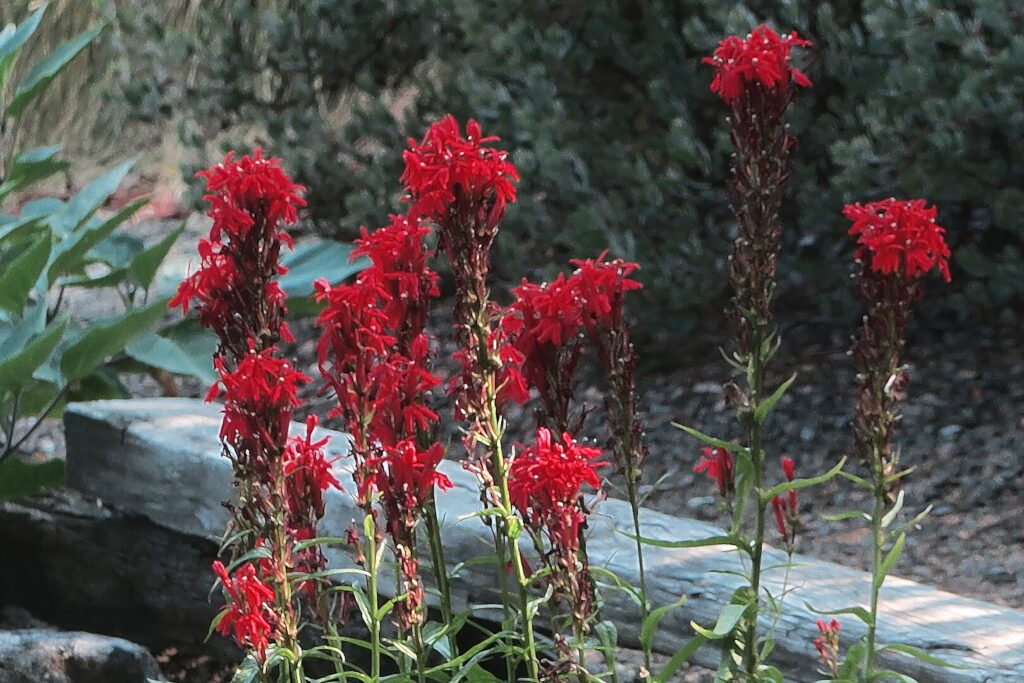
Dedicate individual containers to specific plant species to create specialized wildlife attractants. A container planted exclusively with native water mint attracts beneficial insects while providing aromatic foliage that some birds use in nest construction for its pest-deterrent properties.
Containers planted solely with cardinal flower (Lobelia cardinalis) create hummingbird magnets when positioned near seating areas for optimal viewing. Though technically a marginal rather than aquatic plant, cardinal flower thrives in consistently moist container conditions while producing the brilliant red flowers that ruby-throated hummingbirds prefer.
Seasonal Container Management in Florida
Container ponds require different management strategies during Florida’s distinct wet and dry seasons. During summer’s intense heat, containers may need daily water additions, while winter’s cooler temperatures reduce evaporation rates significantly.
Position containers to receive morning sun but afternoon shade during summer months to prevent overheating. Many aquatic plants perform best with 4-6 hours of direct sunlight, making east-facing locations ideal for most container pond plantings.
During Florida’s winter dry season, container ponds become even more valuable to wildlife as natural water sources diminish. Consider adding small heaters designed for outdoor water features during rare cold snaps to keep water from freezing and to maintain biological activity that supports visiting wildlife.
Wildlife Safety Features
Include gently sloping sides or create shallow beach areas where animals can easily enter and exit. Add logs, branches, or specially designed escape ramps to help small mammals, reptiles, and amphibians that might accidentally fall in. These features also serve as basking spots for turtles and frogs.
Rain Gardens: Sustainable Water Collection
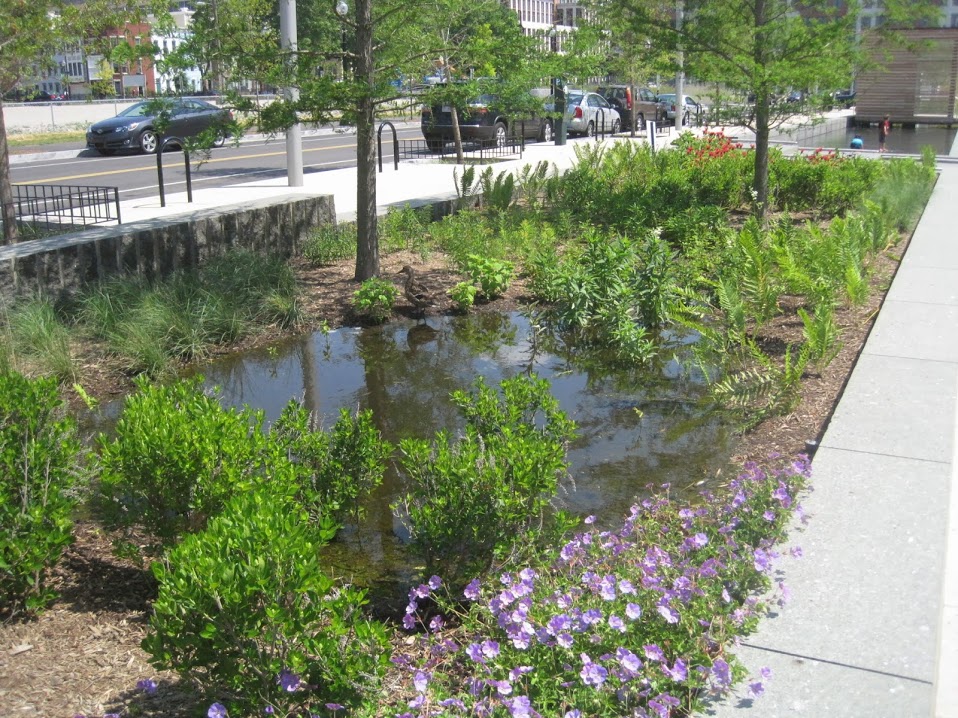
Rain gardens represent an environmentally conscious approach to providing water for wildlife that also addresses Florida’s stormwater management challenges. These depression areas capture and slowly infiltrate rainwater runoff, creating temporary wetland conditions that many native species find irresistible.
Location and Design Principles
Ideal rain garden locations receive runoff from roofs, driveways, or sloped areas while being positioned at least ten feet from building foundations. The garden should be designed to hold water for no more than 24 to 48 hours to prevent mosquito breeding while providing adequate time for soil infiltration and wildlife use.
Size the rain garden to handle approximately 30% of the drainage area feeding into it. For example, a 100-square-foot roof area would require roughly a 30-square-foot rain garden. The depression should be 6 to 8 inches deep with gradually sloping sides that allow easy access for wildlife.
Plant Selection for Florida Rain Gardens
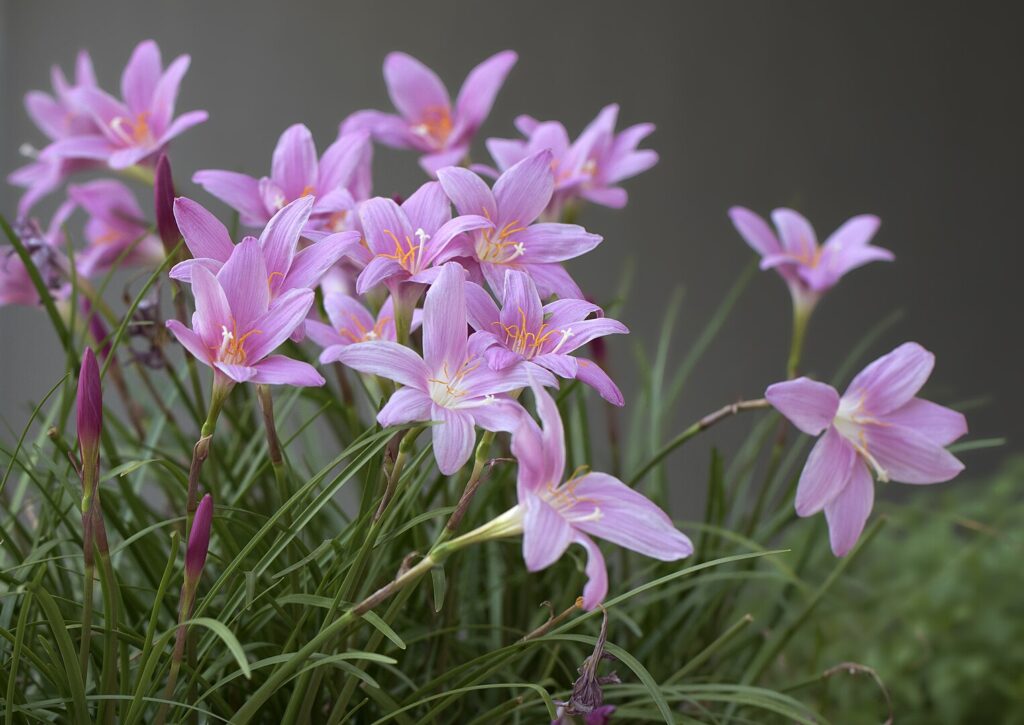
Choose native Florida plants that can tolerate both wet and dry conditions, as rain gardens experience dramatic moisture fluctuations. Excellent options include native rain lilies, firebush, beautyberry, wild bergamot, and various native sedges and grasses. These plants not only handle the moisture extremes but provide food sources and nesting materials for birds and beneficial insects.
The varied moisture conditions in rain gardens create microhabitats that support different species throughout the year. During wet periods, the area attracts amphibians and water-loving insects. As conditions dry out, the garden provides foraging opportunities for birds seeking insects and seeds.
Maintenance and Seasonal Considerations
Rain gardens require minimal maintenance once established, making them perfect for busy gardeners. Remove any accumulated debris after major storms, and occasionally thin aggressive plants to maintain diversity. During Florida’s dry season, you may need to provide supplemental watering to keep plants healthy, which also maintains the area’s attractiveness to wildlife.
Water Dishes: Simple Solutions with Big Impact
Water dishes offer the most straightforward and flexible approach to providing water for wildlife, allowing gardeners to quickly respond to changing conditions and wildlife needs. Their simplicity makes them perfect for renters, small spaces, or as supplements to larger water features.
Strategic Placement Throughout the Garden
Distribute multiple water dishes at different heights and locations throughout your garden to serve various species’ preferences. Ground-level dishes accommodate ground-feeding birds, small mammals, and reptiles, while elevated dishes on pedestals or hung from branches serve different bird species and keep water away from ground predators.
Place dishes near natural cover but with clear sightlines for wildlife to detect approaching threats. The edge of flower beds, near shrub groupings, or under the canopy of larger plants provides the security most animals prefer when drinking.
Size and Depth Variations
Offer dishes of varying sizes and depths to accommodate different species. Shallow saucers with depths of just 1/2 to 1 inch work perfectly for small songbirds, while deeper bowls can serve larger birds, squirrels, and other mammals.
Terra cotta plant saucers make excellent wildlife water dishes due to their natural appearance, rough texture for good grip, and porous material that stays cooler than metal or plastic alternatives.
Daily Refresh Requirements in Florida’s Climate
Florida’s heat and humidity create ideal conditions for rapid bacterial growth and algae formation in standing water. Refresh water dishes daily, scrubbing them clean every few days with a brush and mild soap. During particularly hot spells, you may need to refill dishes twice daily due to evaporation.
Position dishes in partially shaded locations when possible to reduce evaporation and keep water temperatures more comfortable for wildlife. Morning sun with afternoon shade provides ideal conditions for most water dish placements.
Specialized Water Features for Insects
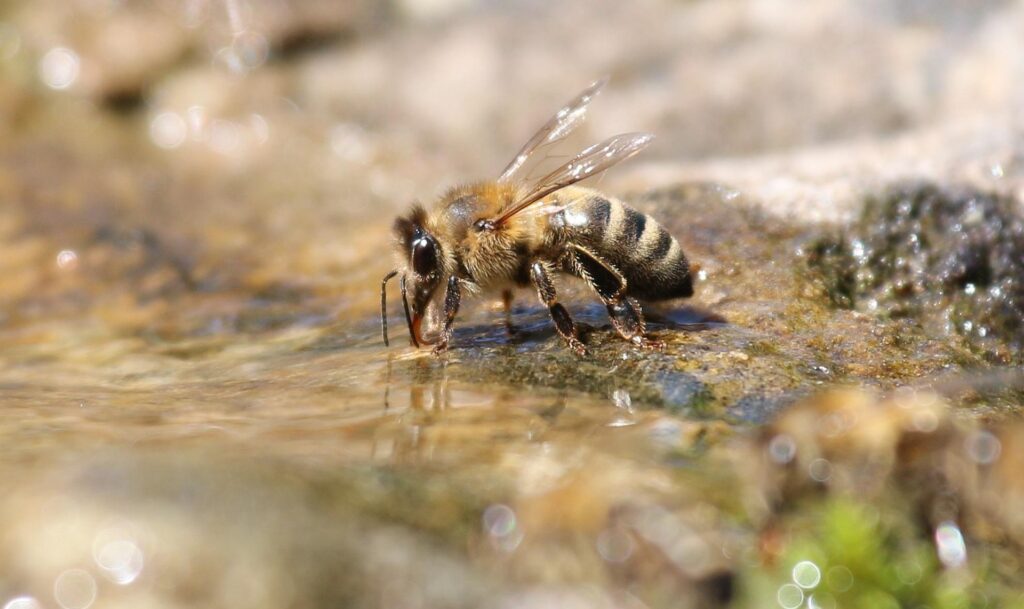
Insects form the foundation of Florida’s ecosystem food webs, and providing appropriate water sources for pollinators and beneficial insects creates cascading benefits throughout your garden. Many insects have unique water requirements that traditional bird baths and ponds don’t address effectively.
Bee Water Stations: Essential for Pollinator Health
Bees require water not just for drinking but also for cooling their hives and diluting honey for feeding larvae. However, bees can easily drown in traditional water features, necessitating specialized designs that provide safe access to shallow water.
Create bee landing strips using shallow dishes filled with clean pebbles, marbles, or wine corks that provide stable footing while allowing access to water between the objects.
Terracotta saucers work exceptionally well due to their natural porosity, which keeps water slightly cooler, and their rough texture that provides additional grip for bee feet.
DIY Bee Water Stations from Recycled Materials
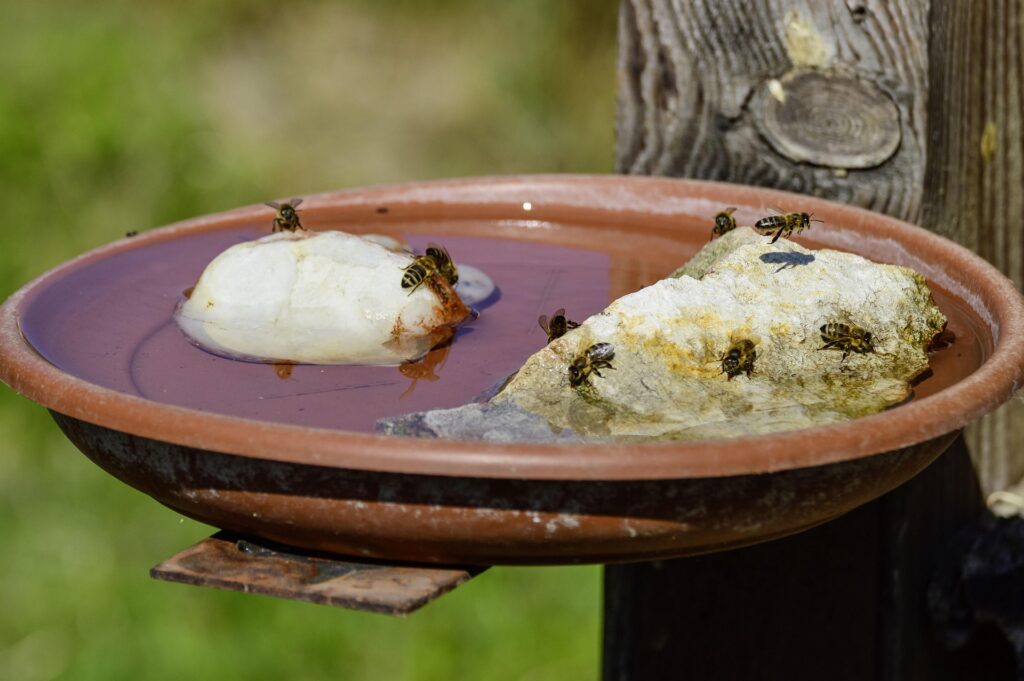
Transform old pie tins or cake pans into effective bee watering stations by filling them with a mixture of clean sand and small pebbles, then adding water until it just covers the substrate. The varied textures create multiple landing zones for different bee species, from tiny sweat bees to large carpenter bees.
Repurpose shallow takeout containers by drilling small drainage holes and filling with aquarium gravel or decorative stones. Position these near bee-friendly plants like native pentas, firebush, or black-eyed Susan to create integrated pollinator support systems.
Wine bottles can be converted into slow-drip bee waterers by inverting them over shallow dishes. Drill a small hole in the cork or cap to control drip rate, creating a consistent water source that doesn’t require daily refilling during Florida’s hot summers.
Butterfly Puddling Stations

Butterflies engage in “puddling” behavior, congregating at muddy areas to obtain minerals and salts essential for reproduction. Male butterflies particularly seek these mineral-rich water sources, making puddling stations excellent for attracting and observing butterfly behavior.
Natural Puddling Area Construction
Create permanent puddling stations by excavating shallow depressions (2-3 inches deep, 12-18 inches across) and filling with a mixture of sand, clay soil, and compost. Add flat stones around the perimeter for butterfly perching and basking opportunities. Position these stations in sunny locations near butterfly host plants and nectar sources.
Container-Based Puddling Solutions
Large terracotta saucers make excellent portable puddling stations. Fill with alternating layers of sand, soil, and compost, topped with decorative river stones. Add a small amount of sea salt or compost tea occasionally to enhance mineral content that butterflies seek.
Repurpose old wheelbarrows or large planters as butterfly puddling gardens by creating miniature wetland environments. Plant native sedges or soft rush in one section while maintaining open muddy areas for puddling behavior.
- 🦋🦋【Bee Water Feeder】🐝🐝 Butterfly Water Feeder Tray, Butterfly Watering Station Ceramic Bee Feeder Water Dish Butterflies Feeder Bee Water Station for Home Yard Garden Decoration. Crafted from Ceramic Material, This Outdoor Water Feeder Is Designed to Butterflies and .
- 🦋🦋【 Ceramic Bowl】🐝🐝 Delicate Bee Feeder Butterfly Feeding Water Dish Birds Food Feeder for Garden. Butterfly Feeding Tray Bee Feeder Water Dish Ceramic Butterflies Feeder Garden Decor. Ceramic Material, This Outdoor Water Feeder Is Not Only Functional but Also Friendly.
- 🦋🦋【Butterfly Feeders for Outdoors】🐝🐝 With Its Large Capacity, This Water Feeder Can Hold More Water, Ensuring That Your Garden Visitors Always Have Enough to Drink.Butterfly Watering Station Outdoor Bee Feeder Watering Butterfly Puddler Stones, Lawn Decoration Ceramic Bowl, Bee Water Station Home Yard Garden
- 🦋🦋【Butterfly Feeding Pot】🐝🐝 The Color of This Water Feeder Adds Elegance and Charm to Any Garden Setting.Butterfly Puddler Butterfly Garden Ornament Bee Watering Station with Glass Marbles Mineral and Butterfly Decoration Can Be Used for Feeding Butterflies and Bees
- 🦋🦋【Ceramic Bee Feeder】🐝🐝 The Unique Design Adds a Touch of Artistry to This Functional and Beautiful Water Feeder.
Creative Insect Water Solutions
Sponge waterers provide excellent water sources for various beneficial insects. Place large natural sponges in shallow dishes and keep them consistently moist. Different insects prefer different sponge textures – coarse sponges for larger insects, fine sponges for tiny beneficial wasps and flies.
Create insect water gardens using shallow wooden boxes lined with plastic and filled with moss, which retains moisture while providing textured landing surfaces. These moss gardens support not just insects but also provide humid microclimates that many beneficial arthropods require.
Strategic Placement for Maximum Insect Benefit
Position insect water features within 10-15 feet of flowering plants to create integrated foraging and hydration zones. Bees and butterflies prefer to minimize energy expenditure between activities, making proximity crucial for feature utilization.
Place multiple small water sources rather than single large ones, as insects often prefer options that feel secure and manageable. Distribute features at different heights – ground level for ground-nesting bees, elevated positions for tree-nesting species.
Water Features for Mammals and Herpetofauna
Florida’s diverse mammal population and abundant reptile and amphibian communities require specialized water feature considerations often overlooked in bird-focused garden design. These vertebrates have unique behavioral patterns and physical requirements that standard bird-oriented features may not address effectively.
Water Sources for Small Florida Mammals
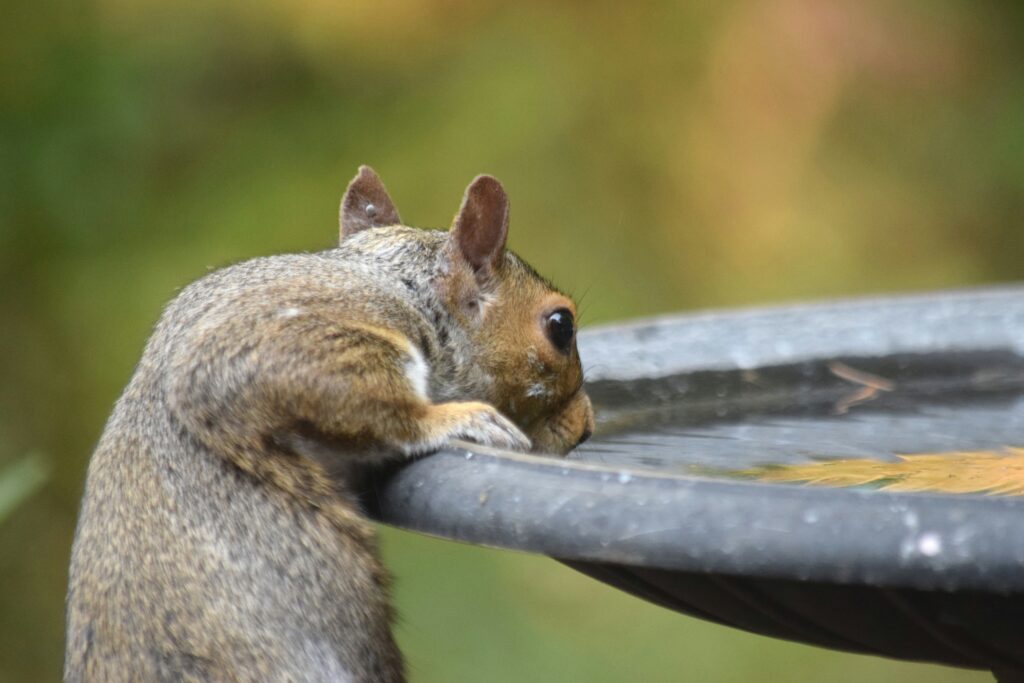
Eastern gray squirrels, Florida’s most visible mammal residents, prefer elevated water sources that provide security while drinking. Install shallow basins on platforms 4-6 feet high, accessible via nearby trees or constructed ramps. Squirrels appreciate basins with rough textures for secure footing and prefer locations near their typical travel routes through tree canopies.
Cotton rats, marsh rabbits, and other small mammals require ground-level access with extensive cover nearby. Create hidden water stations using large plant saucers placed beneath shrub plantings or in areas with overhanging vegetation. These secretive species rarely venture into open areas for water, necessitating concealed placement.
Raccoon-Accessible Water Features
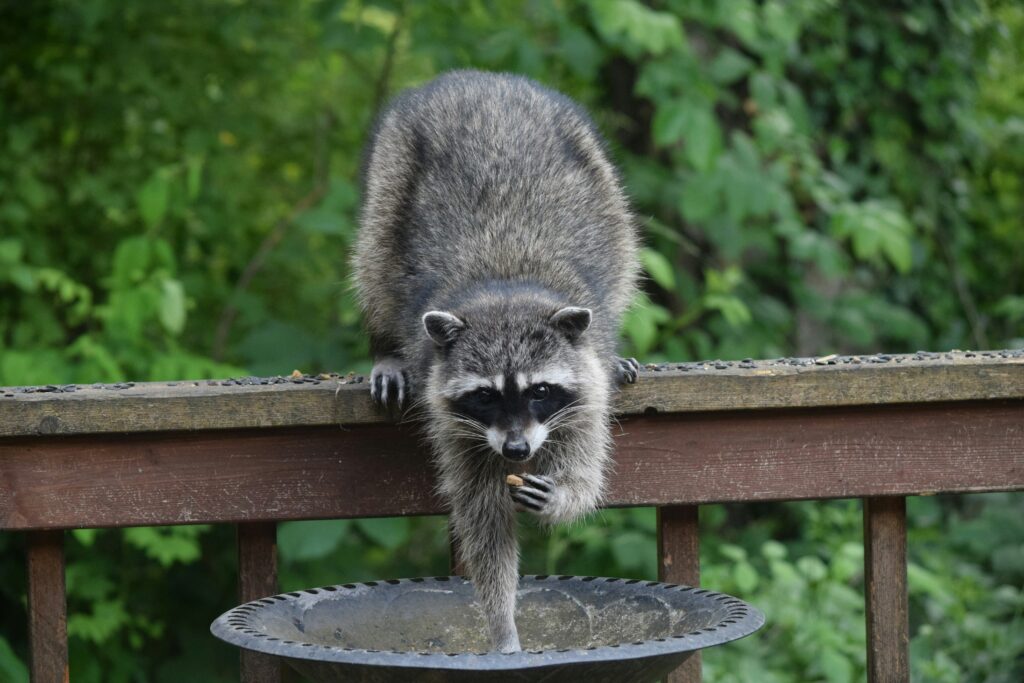
Raccoons require larger, deeper water sources that accommodate their hand-washing behaviors and substantial size. Deep ceramic or stone basins (4-6 inches deep, 18+ inches across) positioned near natural travel corridors serve these intelligent mammals effectively.
Design raccoon water stations with easy cleaning access, as these mammals can be messy users. Heavy stone or ceramic basins resist tipping and displacement while providing the stability raccoons prefer when manipulating food items in water.
Virginia Opossum Considerations
Virginia opossums, Florida’s only native marsupial, prefer ground-level water sources with multiple escape routes. These somewhat clumsy climbers appreciate wide, shallow basins positioned near dense cover but with clear sightlines for predator detection.
Install opossum-friendly water sources near compost areas or fruit trees where these beneficial mammals forage for insects and fallen fruit. Their pest control services make them valuable garden allies deserving of water provision consideration.
Reptile and Amphibian Water Requirements

Florida’s abundant lizard populations have specific hydration needs often met through specialized water features that standard designs overlook. Anoles, geckos, and skinks prefer shallow water sources with extensive perching and basking opportunities adjacent to drinking areas.
Anole and Small Lizard Water Stations
Create lizard water features using shallow dishes surrounded by stacked stones, driftwood, or ceramic tiles that provide basking surfaces adjacent to water access. These territorial reptiles prefer to maintain visual contact with their surroundings while drinking.
Install misting systems near favored lizard basking spots to provide drinking opportunities through water droplets on leaves and surfaces. Many small lizards prefer to drink from water droplets rather than approaching open water sources.
Turtle-Friendly Design Elements
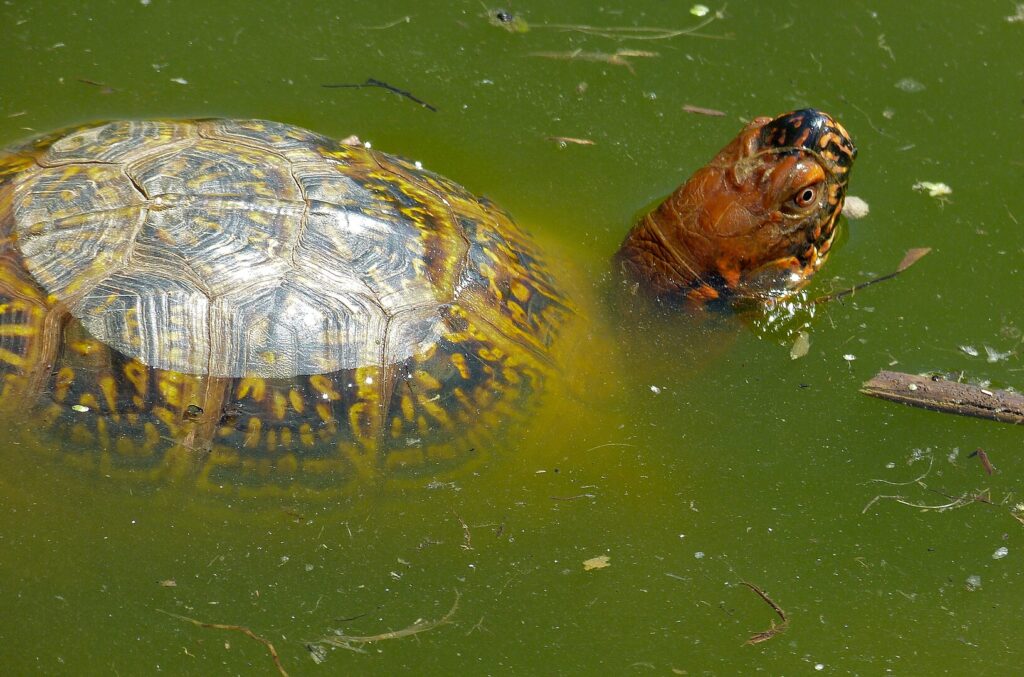
Box turtles, occasionally visiting suburban gardens, require accessible water sources with gentle entry and exit ramps. Create turtle-accessible basins using large, shallow planters with stones or wooden ramps providing easy access for these terrestrial reptiles.
Position turtle water sources in quiet garden areas away from heavy foot traffic, as these shy reptiles avoid areas with frequent disturbance. Include nearby shelter options like brush piles or dense plantings where turtles can retreat after drinking.
Snake Water Provision
Non-venomous snakes like rat snakes, king snakes, and ringneck snakes provide valuable pest control services and deserve water consideration in wildlife-friendly gardens. These species prefer hidden water sources with nearby cover for post-drinking concealment.
Install snake-accessible water features using shallow basins concealed beneath overhanging plants or positioned near brush piles and log arrangements. Snakes are secretive drinkers, preferring locations where they feel secure from predation and human observation.
Amphibian Breeding and Hydration Support
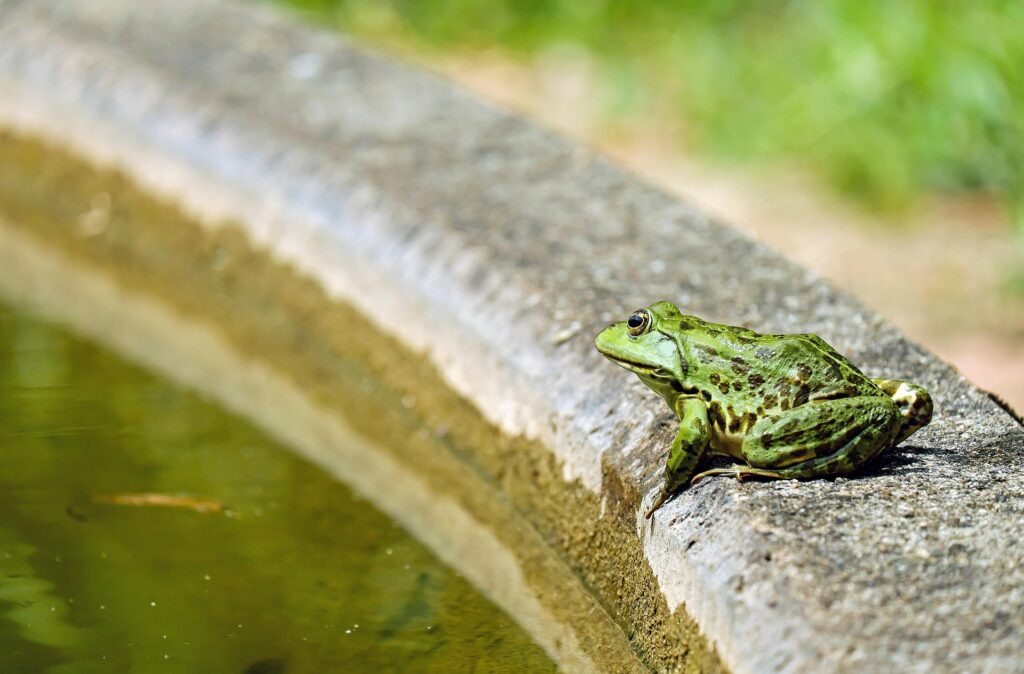
Florida’s diverse frog and toad populations require specialized water features that support both hydration and reproductive needs. Tree frogs need elevated water sources near their typical habitat zones, while terrestrial species prefer ground-level access.
Tree Frog Water Features
Install small water containers in tree forks or on platform feeders to serve tree frog populations. Bromeliads naturally collect rainwater and provide excellent tree frog habitat, but supplemental containers ensure consistent water availability during dry periods.
Green tree frogs and squirrel tree frogs appreciate water sources positioned 4-8 feet high near outdoor lighting that attracts their insect prey. Combine water provision with habitat enhancement for maximum species support.
Terrestrial Amphibian Considerations
Toads and terrestrial frogs require ground-level water access with easy entry and exit capabilities. Create amphibian-friendly water features using shallow dishes recessed into mulch or soil to create naturalistic appearances.
Position amphibian water sources near their preferred daytime hiding spots – beneath decks, in brush piles, or under dense plantings. These species are primarily nocturnal but may need emergency hydration access during extended dry periods.
Integrated Mammal and Herpetofauna Water Systems
Design comprehensive water features that serve multiple species simultaneously through varied access points and depths. Large, naturalistic water features with extensive shallow areas, multiple depths, and diverse surrounding habitats can support mammals, reptiles, and amphibians concurrently.
Create wildlife water complexes using connected basins at different elevations, providing ground-level access for terrestrial species, elevated options for arboreal species, and varied depths for species with different size requirements. These integrated systems maximize wildlife support while minimizing maintenance requirements and garden space utilization.
Garden Fountains: Multi-Species Water Features
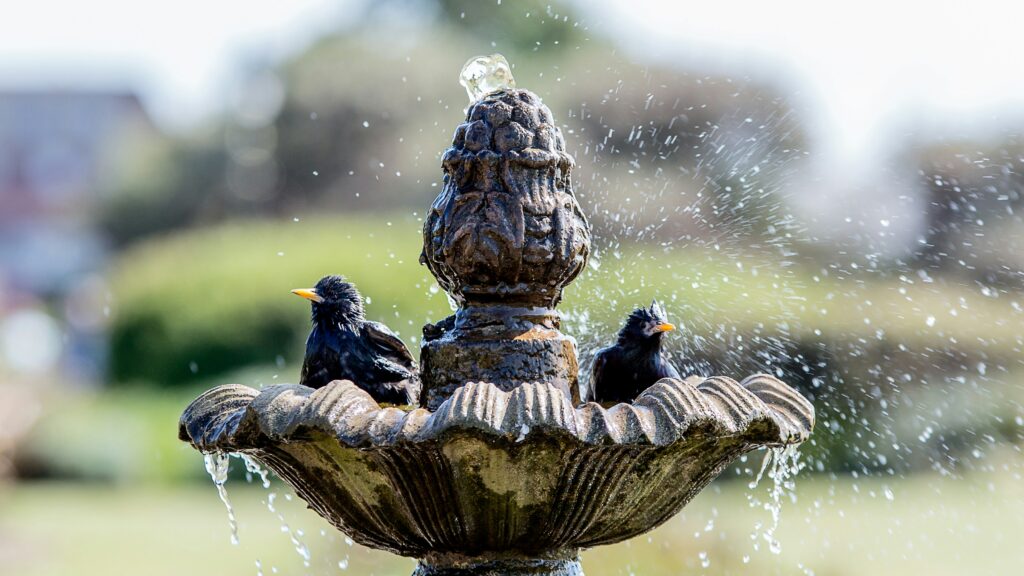
Garden fountains serve multiple wildlife functions while providing aesthetic and auditory benefits for human enjoyment. The sound and movement of fountain water attract species from considerable distances and create dynamic water features that remain fresh and appealing to diverse wildlife.
Bird-Friendly Fountain Design Principles
Traditional fountain designs often fail to accommodate bird needs, but simple modifications create excellent avian water sources. Add shallow catching basins around fountain bases to create drinking and bathing areas with various depths. Birds prefer gradual access rather than steep-sided fountain bowls.
Solar-Powered Fountain Solutions for Sustainability
Solar fountain pumps eliminate electrical costs while providing environmentally sustainable water movement. Position solar panels in full sun locations while placing fountain heads in partially shaded areas to balance energy collection with wildlife comfort.
Create multi-tiered solar fountains using stacked terracotta pots of decreasing sizes. Drill holes for tubing, install a small solar pump in the bottom reservoir, and allow water to cascade through multiple levels, creating various drinking and bathing opportunities for different species.
DIY Fountain Construction from Repurposed Materials
Transform large ceramic planters into fountains by installing submersible pumps and creating overflow systems. Add river rocks around pump intakes to prevent clogging while creating naturalistic appearances that blend with garden aesthetics.
Repurpose old birdbaths as fountain bases by adding small pumps and creating gentle bubbling or spraying effects. The familiar shape continues attracting birds while the water movement prevents stagnation and mosquito breeding.
Accessibility Modifications for Diverse Wildlife
Install multiple water access points at different heights around fountains to serve various species simultaneously. Ground-level catching basins serve mammals and ground-feeding birds, while elevated overflow areas serve perching bird species.
Create textured landing areas using rough stones or attach branches near water streams to provide perching spots for birds that prefer to observe before drinking. Different species have varying comfort levels with water movement, making multiple access options crucial.
Maintenance and Seasonal Management
Florida’s mineral-rich water can quickly clog fountain pumps, necessitating regular cleaning schedules. Install pre-filters or use distilled water in smaller fountains to reduce maintenance requirements while ensuring consistent operation.
During winter months when natural insects are less active, fountain features become even more critical for supporting resident wildlife. Consider adding small heaters to prevent rare freezing while maintaining biological activity that supports visiting species.
Seasonal Considerations for Florida Wildlife Water
Florida’s distinct wet and dry seasons create different challenges and opportunities for wildlife water provision. During the summer wet season, focus on preventing water stagnation and mosquito breeding while taking advantage of natural rainfall. The winter dry season requires more active water management to support wildlife through potentially scarce natural water sources.
Summer Water Management
The abundant rainfall of Florida summers can overwhelm small water features while creating breeding grounds for mosquitoes and other pests. Install overflow drains in ponds and ensure bird baths have adequate drainage.
Consider adding mosquito dunks containing Bacillus thuringiensis israelensis (BTI) to standing water features to control mosquito larvae without harming other wildlife.
Winter Drought Strategies
Florida’s winter dry season can stress wildlife populations as natural water sources disappear. Increase the frequency of water dish changes and consider adding extra water features during this critical period. Battery-operated or solar-powered fountains can keep water moving in bird baths when access to electricity is limited.
Creating Water Feature Combinations
The most successful wildlife gardens incorporate multiple types of water sources to serve the diverse needs of Florida’s fauna. A combination of a small pond with surrounding shallow dishes, a rain garden connected to downspouts, and strategically placed bird baths creates layers of opportunity that support maximum wildlife diversity.
Consider the sight lines between water features, as many animals prefer to see multiple escape routes before committing to drink or bathe. Connect different water sources with pathways of native plants that provide cover and additional food sources, creating wildlife corridors that encourage exploration and use of your entire garden.
Water features require ongoing commitment but reward gardeners with incredible wildlife viewing opportunities and the satisfaction of supporting local ecosystems. Start with simple water dishes and bird baths, then gradually expand your water offerings as you observe which species visit your garden and what additional features might serve their needs.
With proper planning and maintenance, your Florida wildlife garden’s water sources will become magnets for an amazing array of native creatures, transforming your outdoor space into a thriving wildlife habitat.
Start Your Wildlife Water Journey Today
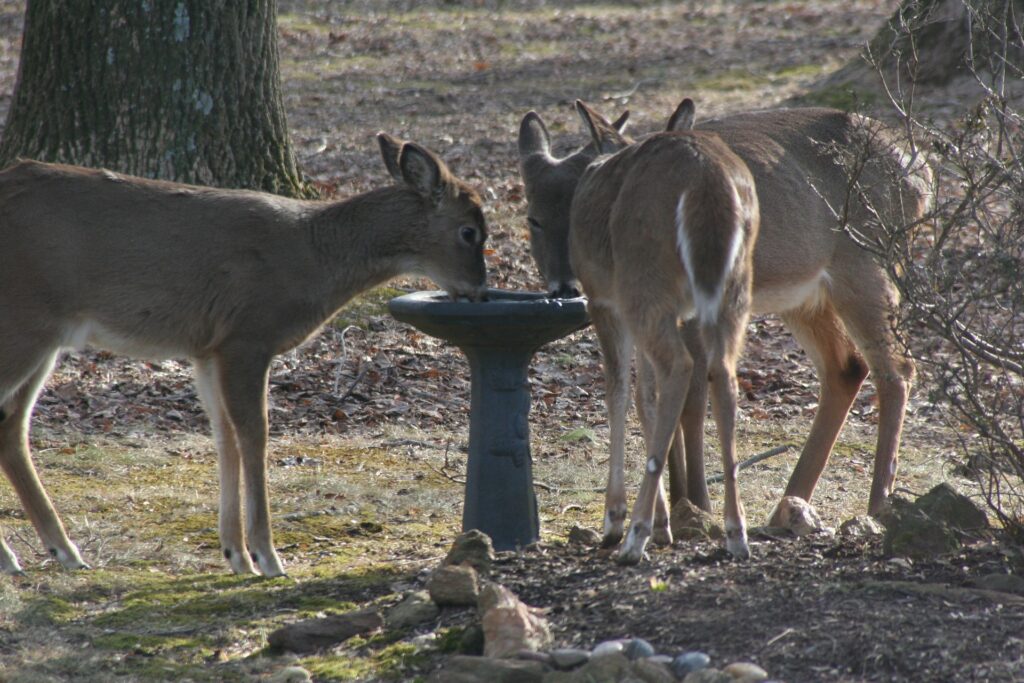
Creating water sources for Florida wildlife isn’t just about supporting local ecosystems – it’s about transforming your outdoor space into a dynamic, living theater where nature’s drama unfolds daily right outside your window.
Every shallow dish you fill, every fountain you install, and every puddling station you create becomes an invitation for wildlife to make your garden their home.
Each garden’s unique conditions – from shady urban courtyards to sunny suburban landscapes – offer opportunities to design water features that serve both wildlife needs and human enjoyment.
Every water feature you create contributes to broader conservation efforts by providing critical habitat in increasingly developed landscapes. Urban and suburban development often eliminates natural water sources, making backyard wildlife gardening an essential component of wildlife corridor creation.
Your seemingly small contributions to provide water for wildlife combine with neighbors’ efforts to create networks of habitat that support wildlife populations across entire regions.
Florida’s wildlife faces increasing challenges from habitat loss, climate extremes, and human development pressures. Your decision to provide water sources represents direct action that makes measurable differences in wildlife survival and reproduction success.
The birds that successfully raise families using your garden’s resources, the pollinators that maintain healthy populations thanks to your bee water stations, and the amphibians that complete their life cycles in your features all represent conservation victories achieved through individual commitment.
Last update on 2025-08-06 / Affiliate links / Images from Amazon Product Advertising API
This product presentation was made with AAWP plugin.




